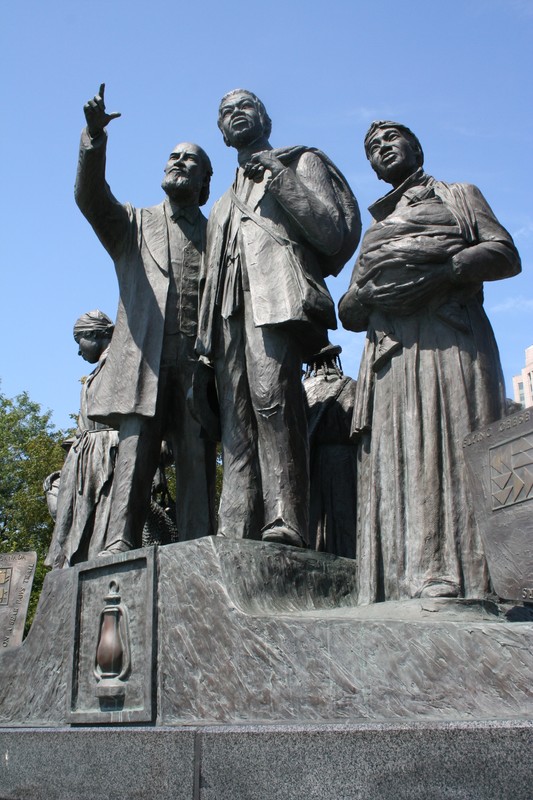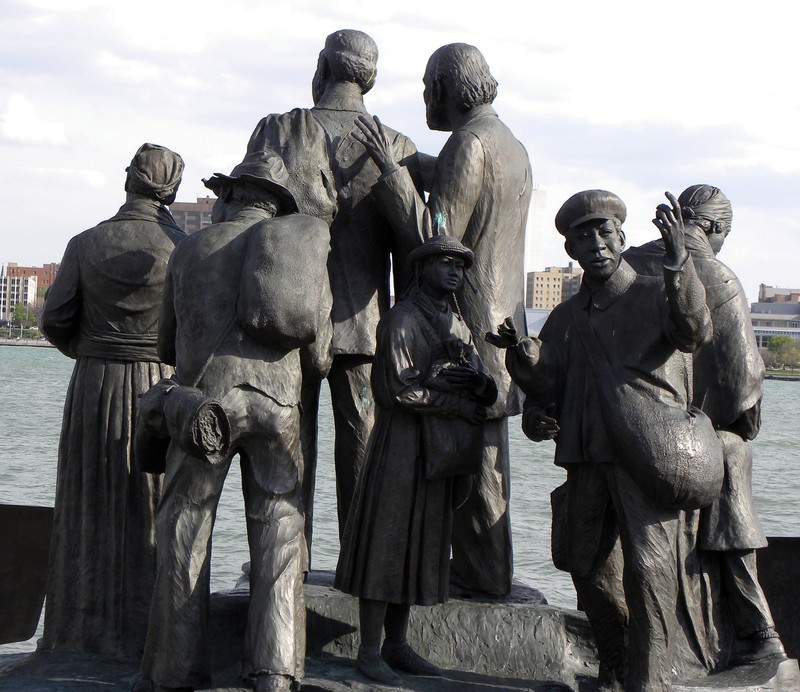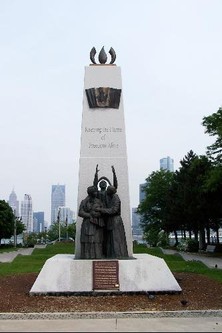Gateway to Freedom International Memorial to the Underground Railroad
Introduction
Text-to-speech Audio
Images
Front side of the Gateway to Freedom International Memorial to the Underground Railroad

Gateway to Freedom memorial looking into Canada

Tower of Freedom memorial in Windsor, Canada

Backstory and Context
Text-to-speech Audio
Detroit’s Role in the Underground Railroad
Throughout the informal underground railroad, with taverns and homes and barns as “stations,” helpers as “conductors,” and runaway slaves as “passengers” or “baggage,” Detroit has always remained at the forefront. The city even earned the name of “Doorway to Freedom.” Beginning in the late 18th-century and early 19th century, Detroit’s geographical location in combination with its community of radicalized African Americans and abolitionist sympathizers served as an integral passing point into Canada. Having a safe passage into Canada was especially important after the 1850 Fugitive Slave Act.
With the help of Seymour Finney, owner of the Finney Hotel, and feminist writer Elizabeth Chandler, the city gave birth to a widespread anti-slavery society. George de Baptiste, a free man from Virginia who moved to Detroit as an adult, formed a secret organization known as the African-American Mysteries or Order of the Men of Oppression, and Baptiste used boats to secretly transport passengers across the river. Detroit was also home to abolitionist leaders such as John Brown, Sojourner Truth and Frederick Douglass, who worked with the Second Baptist Members of the congregation to form two other anti-slavery organizations, the Amherstburg Baptist Association and the Canadian Anti-Slavery Baptist Organization.1
The community and resources for abolition, aiding the Underground Railroad, were prolific in Detroit, and estimates state that over 45,000 runaway slaves passed through Detroit.
The Gateway to Freedom Memorial
Before creating the Gateway to Freedom Memorial, Sculptor Ed Dwight played a pivotal role in contemporary African American society. The son of Ed Dwight, Sr., a second baseman for the Kansas City Monarchs of the segregated Negro League, Ed Dwight Jr. was the first African American accepted into the US astronaut training program in 1962 after a recommendation from President John F. Kennedy. However, he resigned from the program in 1966 and reclaimed his passion for art in 1974. Dwight’s first professional job was to create a sculpture for the Colorado capitol building. After other major projects aimed at documenting the often unknown contributions of African Americans, Dwight won a design competition in 2001 from Detroit 300, a non-profit group that was organizing Detroit’s tricentennial.
Dedicated on October 20, 2001, the Gateway to Freedom memorial features eight larger-than-life figures getting ready to cross the river into freedom. George de Baptiste is at the center, pointing a finger toward Canada. Next to Baptiste is a woman, man, and infant, and in the Canada memorial, a male and female figure have their backs facing the US, facing into the Promised Land.2
Inscription on ‘The Gateway to Freedom’ Marker
Until Emancipation, Detroit and the Detroit River community served as the gateway to freedom for thousands of African American people escaping enslavement. Detroit was one of the largest terminals of the Underground Railroad, a network of abolitionists aiding enslaved people seeking freedom. Detroit's Underground Railroad code name was Midnight. At first, Michigan was a destination for freedom seekers, but Canada became a safer sanctuary after slavery was abolished there in 1834. With passage of the Fugitive Slave Act in 1850, many runaways left their homes in Detroit and crossed the river to Canada to remain free. Some returned after Emancipation in 1863.
The successful operation of Detroit's Underground Railroad was due to the effort and cooperation of diverse groups of people, including people of African descent, Whites, and North American Indians. This legacy of freedom is a vital part of Detroit and its history.3
Cite This Entry
Newcomer, Daniel and Clio Admin. "Gateway to Freedom International Memorial to the Underground Railroad." Clio: Your Guide to History. July 20, 2017. Accessed April 27, 2025. https://theclio.com/tour/465/2

